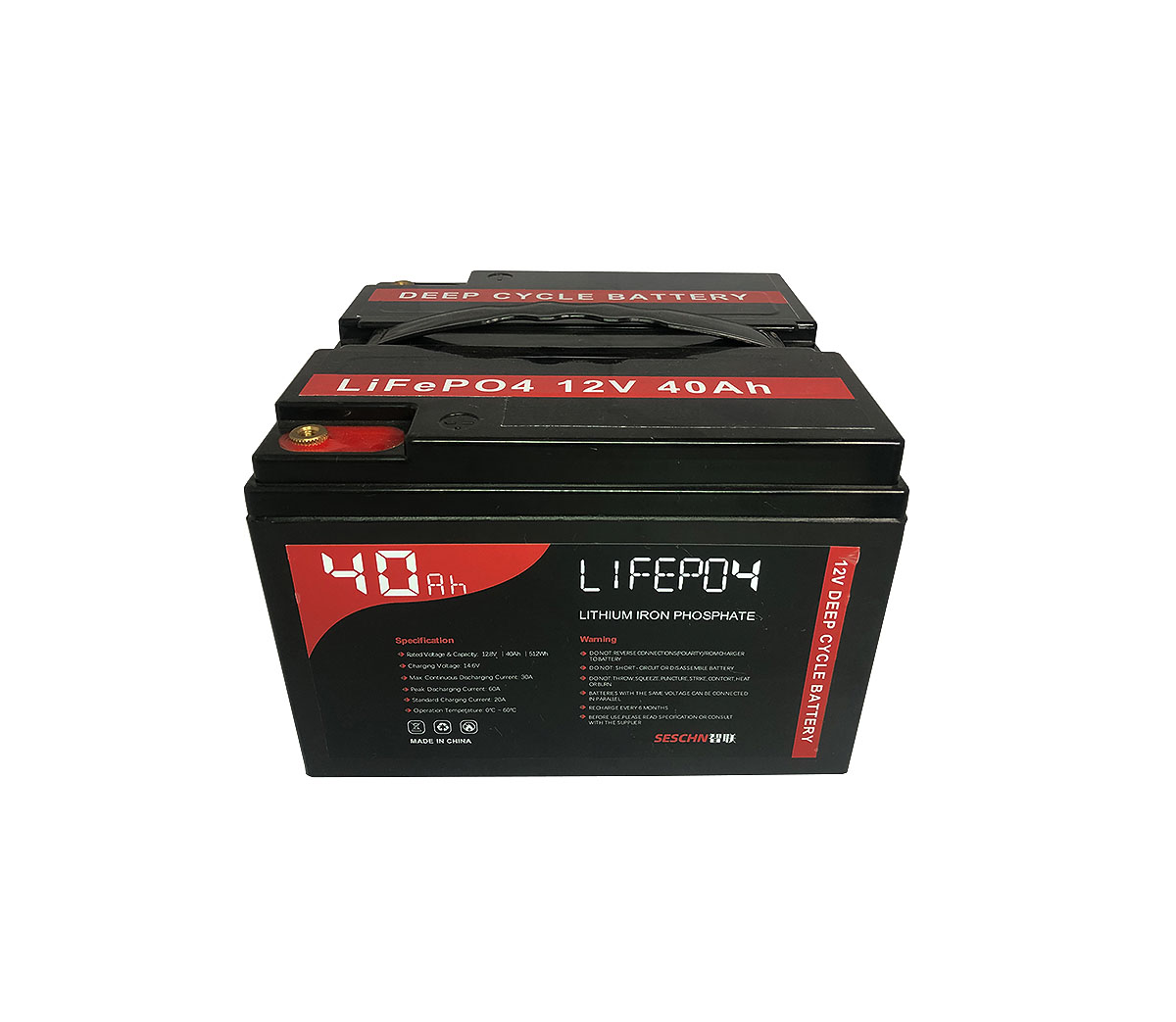Lithium-ion batteries (LIBs) have become the main energy storage solutions
in modern social life. Among them, lithium iron phosphate battery perfectly
replaces lead-acid battery, and is the first choice for grid-connected peak
regulation, off-grid energy storage, photovoltaic energy storage, UPS system,
data center and other industries.
Although SES Power has been focusing on the application of lithium iron
phosphate batteries in the past ten years, we still have many products that use
3.7V lithium cobalt oxide batteries and ternary lithium batteries, and the
brands used are Panasonic, Sanyo, Samsung, LG, BAK and other international
famous brands, such as our AGV batteries, home electronics batteries, personal
care products batteries and so on.
The ternary lithium battery is very popular in the market because of its
high energy density and suitable price, and SES Power also pays attention to its
development. For lithium batteries, the decisive factor is actually the
development of the positive electrode material of the battery. Now let's briefly
talk about the development trend of cathode materials for ternary lithium
batteries on the market.
1: High nickel ternary material
Nickel-Cobalt-Manganese has the characteristics of high specific capacity,
long cycle life, low toxicity and cheapness. In addition, the three elements
have good synergistic effect, so they have been widely used.
In redox energy storage, nickel is the main component. How to effectively
increase the specific capacity of the material by increasing the content of
nickel in the material is one of the current research hotspots.
Generally speaking, high-nickel ternary cathode material means that the
mole fraction of nickel in the material is greater than 0.6. Such a ternary
material has the characteristics of high specific capacity and low cost, but
also has low capacity retention rate, poor thermal stability, etc. defect.
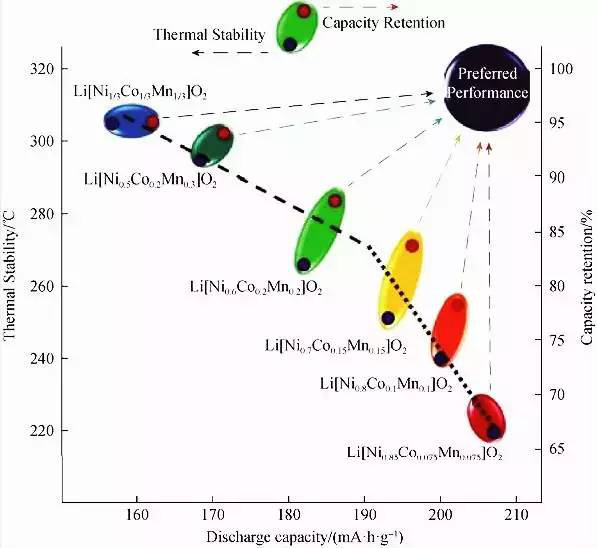
The material properties can be effectively improved through the improvement
of the preparation process. The micro-nano size and morphological structure of
the particles determine the performance of the high-nickel ternary cathode
material to a large extent. Therefore, the main preparation method at present is
to uniformly disperse different raw materials and obtain nano-spherical
particles with large specific surface area through different growth
mechanisms.
2: Lithium-rich ternary material
The figure below is a schematic diagram of the structure of the
lithium-rich ternary cathode material xLi2MnO3·(1-x)LiMn1/3Ni1/3Co1/3O2
(0.1≤x≤0.5). Due to its special structure, more lithium can be extracted and it
has a wide voltage The advantages of window and high energy density ratio have
been favored by researchers in recent years.
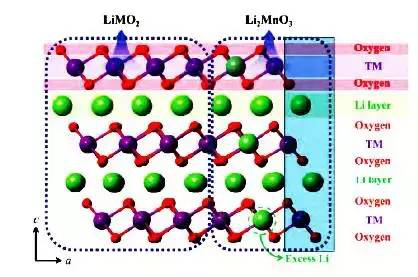
All of this material is characterized by high voltage, and the first
charge-discharge mechanism is different from the subsequent charge: the first
charge causes structural changes! This change is reflected in the charging curve
with two different plateaus demarcated by 4.4 V. During the second charging
process, the charging curve is different from that of the first one, because
Li2O is removed from the layer during the first charging process. The structure
of Li2MnO3 is irreversibly extracted, and the plateau disappears at around
4.5V.
Lithium-rich ternary materials show good application prospects and are one
of the key materials required for next-generation high-capacity lithium-ion
batteries, but research continues for large-scale applications. The material has
the following practical problems that urgently need to be solved by industry
researchers:
(1) Insufficient understanding of the mechanism of lithium extraction and
intercalation, unable to explain the phenomenon that the coulombic efficiency of
materials will be low and the material properties will vary greatly;
(2) The research on doping elements is not sufficient and relatively
single;
(3) Poor cycle stability due to the corrosion of the positive electrode
material by the electrolyte at high voltage;
(4) There are few commercial applications, and the investigation on safety
performance is not comprehensive enough.
3: Single crystal ternary cathode material
The single-crystal high-voltage ternary material can improve the lithium
ion transfer efficiency and reduce the side reaction between the material and
the electrolyte, thereby improving the cycle performance of the material under
high voltage.
This material is a ternary cathode composite material with excellent
electrochemical properties and a good layered structure. At 3-4.4 V, the 0.1
discharge specific capacity of the coin cell battery can reach 186.7 mAh/g, and
the discharge specific capacity of the full battery after 1300 cycles is still
98% of the initial discharge capacity.
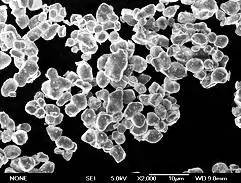
4: Graphene doping
Graphene has a two-dimensional structure with a single-layer atomic
thickness, which is structurally stable and has an electrical conductivity of up
to 1×106 S/m. The use of graphene in lithium-ion batteries has the following
advantages: ① good electrical and thermal conductivity, which helps to improve
the rate performance and safety of the battery; ② compared with graphite,
graphene has more lithium storage space, which can improve the energy density of
the battery; ③ The particle size is in the micro-nano scale, and the diffusion
path of lithium ions is short, which is beneficial to improve the power
performance of the battery.
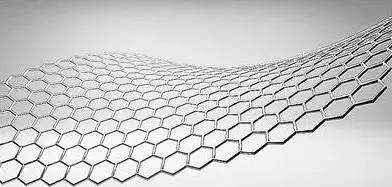
5: High Voltage Electrolyte
Ternary materials have received more and more attention and research due to
their high voltage windows. However, due to the low electrochemical stability
window of the current commercial carbonate-based electrolytes, high-voltage
cathode materials have not yet been industrialized.
When the battery voltage reaches about 4.5V, the electrolyte begins to
undergo violent oxidative decomposition, which leads to the failure of the
lithium intercalation and delithiation reaction of the battery to proceed
normally. Improving the stability of the electrode/electrolyte interface by
developing and applying new high-voltage electrolyte systems or high-voltage
film-forming additives is an effective way to develop high-voltage
electrolytes.
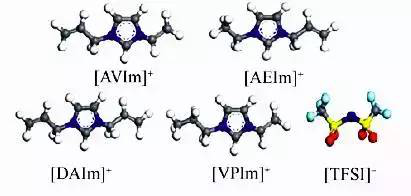
In energy storage systems, ionic liquids, dinitrile organic compounds and
sulfone organic solvents are currently used as electrolytes for high-voltage
ternary materials. Ionic liquids with low melting point, non-flammability, low
vapor pressure, and high ionic conductivity exhibit excellent electrochemical
stability and have been extensively studied.
6: Plasma synthesis method
When using the traditional high-temperature calcination method to prepare
the ternary cathode material, the required synthesis temperature is high, the
calcination time is long, and the energy loss is large.
The study found that in the low temperature plasma environment, the
chemical activity of each reactant is high and the chemical reaction speed is
fast, which can realize the rapid preparation of ternary cathode materials. The
oxides of nickel cobalt manganese and lithium carbonate are mixed uniformly, and
then placed in a plasma generator, under the condition of introducing oxygen,
and reacting at 600 ° C for 20 to 60 minutes to obtain a ternary cathode
material Li (Ni1/3Co1/3Mn1 /3) O2.

7: Preparation of ternary cathode materials from waste batteries
The cost of cathode materials for lithium-ion batteries accounts for
30%-40%. Therefore, the energy storage performance of cathode materials can be
recovered by recycling the cathode materials of waste batteries and the
preparation process, which can greatly reduce the cost of lithium-ion batteries,
and a complete the lithium-ion battery industry chain should include the
recycling of lithium-ion batteries.

















